Depending on the load and dimensions of the structure, footing requirements and measurements will vary. These requirements include the depth and diameter of each individual footing and the distance between them. All of this information is available in Australian Standards AS1684 and AS2870, and a structural engineers advice for appropriate footing will be indispensable.
Benefits of Post Supports
a) Timber Decay Prevention
Post Supports create a gap between the timber end and the concrete, which prevents moisture from the ground directly contacting the timber. Consistent wetting and drying of timber without adequate preventative measures can lead to rot, which in turn can lead to a shorter lasting timber structure.
b) Easy installation process
Especially when there is existing concrete where the timber structure will be build, there is generally only a need to install anchoring bolts into the concrete base to secure.
Casting in a post support is as simple as aligning it correctly and temporarily securing until the concrete is cured.
c) Termite inspection compliance
For locations prone to termite activity, a 75mm clearance between timber and ground allows for easier inspection and is required by Australian Standards to mitigate termite activity and damage.
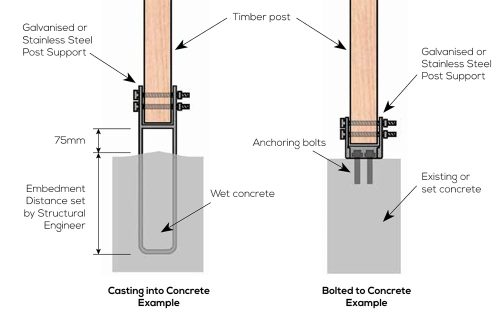
Post Support Anchoring Methods
a) Casting into wet concrete
The embedment depth and each post location should be determined by a Structural Engineer, who will use the relevant post support technical data sheet to calculate the dead and uplift loads. The type of concrete used, along with the aggregate ratio also play a part in embedment depth requirements.
b) Bolt down onto existing concrete
If the site already has a concrete base, bolt down post supports allow for a strong connection to ground, and are secured by anchoring bolts. The concrete type and quality may vary for each site, and the Structural Engineer will advise on locations of installation and most suitable post support type.
VUETRADE™ Installation Guide – How to install Post Supports in Deck Footings
Download PDF Installation Guide You can read here or download the VUETRADE™ Installation Guide on the link above. Depending on the load and dimensions of the deck, footing requirements and measurements do vary. These requirements include the depth and diameter of each individual footing and the distance between them. All of these information is available in AS 1684 and AS 2870. However, a quicker and cheaper alternative is enquire with the local building authority, to save the hassle of buying and going through the Australian Standards. There are two different ways of casting concrete footings. Method 1: Embed a VUETRADE™ Post Support into wet concrete. A 75mm minimum clearance between the post to the base support is required by the Building Codes of Australia (BCA) and Australian Standards, illustrated in Figure 1 and the stirrup needs to extend to at least 100mm into the wet concrete to be able to achieve its respective design capacities. The 75mm clearance acts as a termite inspection zone for local building authorities and also to increase the lifespan of the post. Most common error occurs when the galvanised post stirrups are embedded into the concrete without clearance from the base which causes the timber posts to be in direct contact with the concrete. Concrete absorbs moisture, keeping the posts moist. This can potentially cause premature rotting in the timber post which results in a decreased performance its structural integrity. A list of VueTrade™ products are tabulated in Table 1. Method 2: Embed the post into the concrete footing. To do so, BCA states that the holes for the embedded posts is filled with 100mm depth of coarse gravel before backfilling with concrete, shown in Figure 1. However, this method is not recommended as only specific species of timber are allowed to be embedded into wet concrete.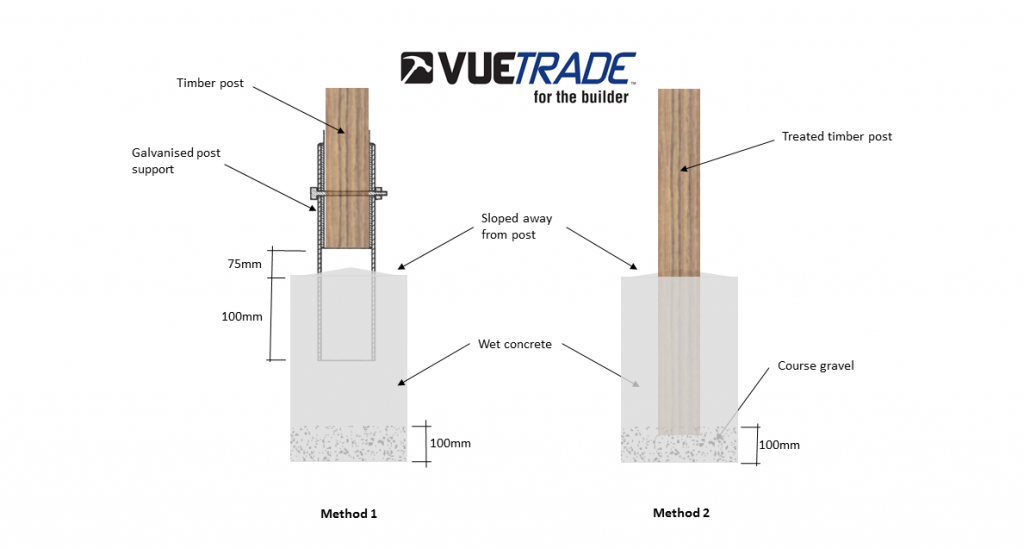 Table 1: VUETRADE™ Post Supports
Table 1: VUETRADE™ Post Supports
| Purpose | Existing Concrete Substrate | Set into Wet Concrete | |||
| VUETRADE™ Products | Bolt Down Post Supports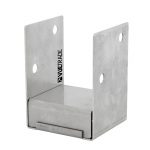 |
T Blade Post Supports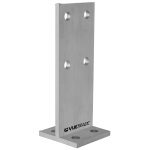 |
Full Stirrup Post Supports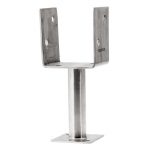 |
Cyclonic Post Supports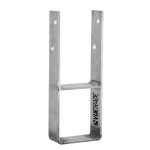 |
Bladed Post Supports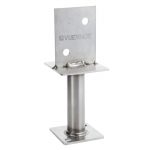 |
| Dimensions Available | Galvanised Stirrup Size: 90mm, 100mm, 115mm, 125mm Stainless Steel Stirrup Size: 90mm, 100mm, 115mm, 125mm 135mm, 200mm | Galvanised Size (mm): Four sizes to suit posts from 90 to 200 square Stainless Steel Size (mm): Four sizes to suit posts from 90 to 200 square | Wide range of sizes in both Galvanised and Stainless Steel available. | Wide range of sizes in both Galvanised and Stainless Steel available. | Galvanised Heights: 125mm, 300mm Stainless Steel Heights: 125mm, 300mm |
